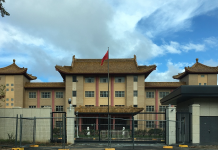BEIJING: In Heilongjiang, China’s northeasternmost province bordering Russia, the New Year started on a dismal note. On January 10, a 30-year-old woman became the first reported novel coronavirus disease (COVID-19) patient in the province after months of no new infection.
More cases surfaced. The next day, 45 asymptomatic cases were reported, all from the village in Wangkui County where the woman’s father lives. Soon there were several hundred confirmed and asymptomatic cases.
On examination, the father was also found to be asymptomatic. He had led an active social life in the past few days, including dining at a restaurant and taking part in two weddings, where he could have got the infection.
The trail of infections continued via the bus the man took to return home from a wedding. Among the passengers were a couple from Jilin Province in the northeast. They took a train back to their home city one week later and subsequently, were diagnosed as asymptomatic. By that time the virus had spread to other passengers who shared the same carriage with them on the train. By January 20, Jilin had reported 162 confirmed cases.
Speaking about why the cases popped up in rural areas, Liu Youning, a professor of respiratory medicine at the Chinese PLA General Hospital, told China News Service that people in rural areas have a weak awareness of COVID-19. Many people do not go to see a doctor if their symptoms are mild.
Besides, compared with cities, rural areas have weaker medical service capacities. In Hebei Province, north China, some doctors in villages couldn’t identify COVID-19 cases, delaying treatment for some patients.
Besides, the sense of hygiene is weak in some rural areas, Liang Xiaofeng, Vice President and Secretary General of the Chinese Preventive Medicine Association, said. Some people still do not have good hygiene habits.
It was the same in Hebei where the new COVID-19 cases were mostly reported in rural areas, which raised the alarm for epidemic control in such areas.
The first confirmed case in Hebei this year was reported on January 2. A 61-year-old woman from a village visited her sister in another village and took part in a wedding feast in a restaurant. Soon Hebei reported several hundred cases within days while it had no new infections for months. Many of those infected had taken part in mass gatherings such as village fairs.
A villager called Li Jie in Wangkui told Xinhua News Agency that in winter since there is little farm work, people participate in mass gatherings, especially weddings. Some villagers had attended three to four weddings despite the warnings against mass gatherings.
According to a press conference on epidemic prevention and control held by Hebei’s local authorities on January 12, most of the current outbreaks in the province were in rural areas. They accounted for 70 percent of the cases as of January 12. Once the new breeding ground of the disease was detected, the local authorities in Heilongjiang and Hebei swung into action to contain it. City-wide mass nucleic acid testing started. In Shijiazhuang, capital of Hebei, over 5,000 people from three villages with the most serious epidemic situation were put under centralized quarantine and medical observation.
– The Daily Mail-Beijing Review News exchange item






